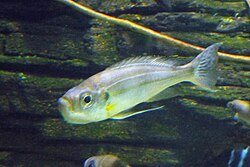| Haplotaxodon | |
|---|---|
 | |
| Haplotaxodon trifasciatus | |
| Scientific classification | |
| Domain: | Eukaryota |
| Kingdom: | Animalia |
| Phylum: | Chordata |
| Class: | Actinopterygii |
| Order: | Cichliformes |
| Family: | Cichlidae |
| Tribe: | Perissodini |
| Genus: | Haplotaxodon Boulenger, 1906 |
| Type species | |
| Haplotaxodon microlepis Boulenger, 1906 | |
Haplotaxodon is a genus of cichlids endemic to Lake Tanganyika in Africa.